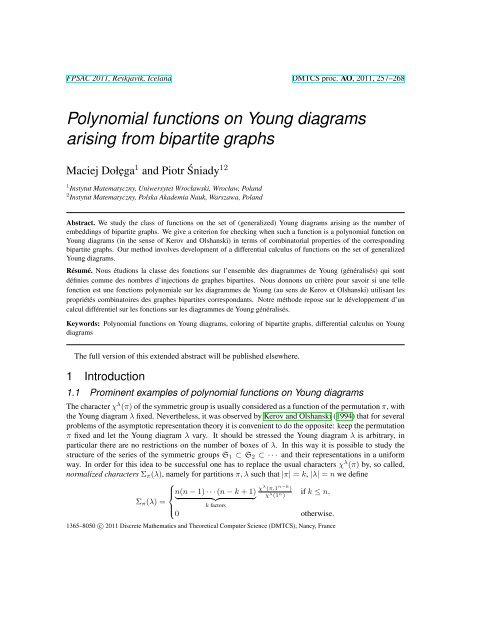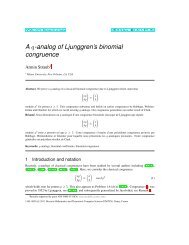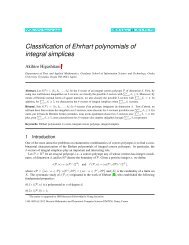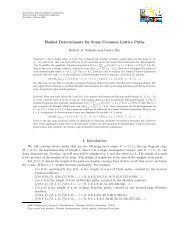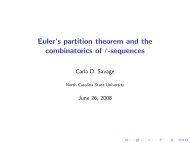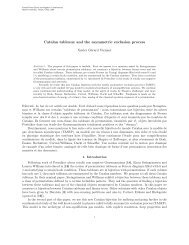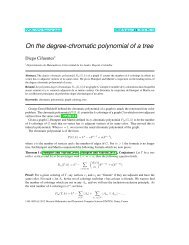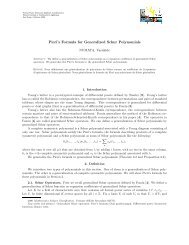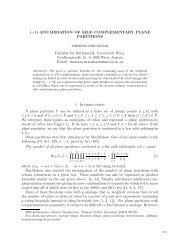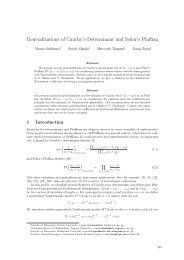Polynomial functions on Young diagrams arising from bipartite graphs
Polynomial functions on Young diagrams arising from bipartite graphs
Polynomial functions on Young diagrams arising from bipartite graphs
Create successful ePaper yourself
Turn your PDF publications into a flip-book with our unique Google optimized e-Paper software.
FPSAC 2011, Reykjavík, Iceland DMTCS proc. AO, 2011, 257–268<br />
<str<strong>on</strong>g>Polynomial</str<strong>on</strong>g> <str<strong>on</strong>g>functi<strong>on</strong>s</str<strong>on</strong>g> <strong>on</strong> <strong>Young</strong> <strong>diagrams</strong><br />
<strong>arising</strong> <strong>from</strong> <strong>bipartite</strong> <strong>graphs</strong><br />
Maciej Dołęga 1 and Piotr Śniady 12<br />
1 Instytut Matematyczny, Uniwersytet Wrocławski, Wrocław, Poland<br />
2 Instytut Matematyczny, Polska Akademia Nauk, Warszawa, Poland<br />
Abstract. We study the class of <str<strong>on</strong>g>functi<strong>on</strong>s</str<strong>on</strong>g> <strong>on</strong> the set of (generalized) <strong>Young</strong> <strong>diagrams</strong> <strong>arising</strong> as the number of<br />
embeddings of <strong>bipartite</strong> <strong>graphs</strong>. We give a criteri<strong>on</strong> for checking when such a functi<strong>on</strong> is a polynomial functi<strong>on</strong> <strong>on</strong><br />
<strong>Young</strong> <strong>diagrams</strong> (in the sense of Kerov and Olshanski) in terms of combinatorial properties of the corresp<strong>on</strong>ding<br />
<strong>bipartite</strong> <strong>graphs</strong>. Our method involves development of a differential calculus of <str<strong>on</strong>g>functi<strong>on</strong>s</str<strong>on</strong>g> <strong>on</strong> the set of generalized<br />
<strong>Young</strong> <strong>diagrams</strong>.<br />
Résumé. Nous étudi<strong>on</strong>s la classe des f<strong>on</strong>cti<strong>on</strong>s sur l’ensemble des diagrammes de <strong>Young</strong> (généralisés) qui s<strong>on</strong>t<br />
définies comme des nombres d’injecti<strong>on</strong>s de graphes <strong>bipartite</strong>s. Nous d<strong>on</strong>n<strong>on</strong>s un critère pour savoir si une telle<br />
f<strong>on</strong>cti<strong>on</strong> est une f<strong>on</strong>cti<strong>on</strong>s polynomiale sur les diagrammes de <strong>Young</strong> (au sens de Kerov et Olshanski) utilisant les<br />
propriétés combinatoires des graphes <strong>bipartite</strong>s corresp<strong>on</strong>dants. Notre méthode repose sur le développement d’un<br />
calcul différentiel sur les f<strong>on</strong>cti<strong>on</strong>s sur les diagrammes de <strong>Young</strong> généralisés.<br />
Keywords: <str<strong>on</strong>g>Polynomial</str<strong>on</strong>g> <str<strong>on</strong>g>functi<strong>on</strong>s</str<strong>on</strong>g> <strong>on</strong> <strong>Young</strong> <strong>diagrams</strong>, coloring of <strong>bipartite</strong> <strong>graphs</strong>, differential calculus <strong>on</strong> <strong>Young</strong><br />
<strong>diagrams</strong><br />
The full versi<strong>on</strong> of this extended abstract will be published elsewhere.<br />
1 Introducti<strong>on</strong><br />
1.1 Prominent examples of polynomial <str<strong>on</strong>g>functi<strong>on</strong>s</str<strong>on</strong>g> <strong>on</strong> <strong>Young</strong> <strong>diagrams</strong><br />
The character χ λ (π) of the symmetric group is usually c<strong>on</strong>sidered as a functi<strong>on</strong> of the permutati<strong>on</strong> π, with<br />
the <strong>Young</strong> diagram λ fixed. Nevertheless, it was observed by Kerov and Olshanski (1994) that for several<br />
problems of the asymptotic representati<strong>on</strong> theory it is c<strong>on</strong>venient to do the opposite: keep the permutati<strong>on</strong><br />
π fixed and let the <strong>Young</strong> diagram λ vary. It should be stressed the <strong>Young</strong> diagram λ is arbitrary, in<br />
particular there are no restricti<strong>on</strong>s <strong>on</strong> the number of boxes of λ. In this way it is possible to study the<br />
structure of the series of the symmetric groups S 1 ⊂ S 2 ⊂ · · · and their representati<strong>on</strong>s in a uniform<br />
way. In order for this idea to be successful <strong>on</strong>e has to replace the usual characters χ λ (π) by, so called,<br />
normalized characters Σ π (λ), namely for partiti<strong>on</strong>s π, λ such that |π| = k, |λ| = n we define<br />
⎧<br />
χ<br />
⎪⎨ n(n − 1) · · · (n − k + 1)<br />
λ (π,1 n−k )<br />
if k ≤ n,<br />
} {{ }<br />
χ λ (1 n )<br />
Σ π (λ) =<br />
k factors<br />
⎪⎩<br />
0 otherwise.<br />
1365–8050 c○ 2011 Discrete Mathematics and Theoretical Computer Science (DMTCS), Nancy, France
258 Maciej Dołęga and Piotr Śniady<br />
There are several other interesting examples of <str<strong>on</strong>g>functi<strong>on</strong>s</str<strong>on</strong>g> <strong>on</strong> the set of <strong>Young</strong> <strong>diagrams</strong> which in some<br />
sense — which will be specified in Secti<strong>on</strong> 1.2 — are similar to the normalized characters; we recall some<br />
of them in the following.<br />
Free cumulants R k (λ), introduced by Kerov (2000a) and Biane (2003), are relatively simple functi<strong>on</strong>als<br />
of the shape of the <strong>Young</strong> diagram λ. Their advantage comes <strong>from</strong> the fact that the normalized characters<br />
can be expressed in terms of free cumulants and that this expressi<strong>on</strong> takes a particularly simple form<br />
(Biane, 2003).<br />
There are other interesting functi<strong>on</strong>als of the shape of the <strong>Young</strong> diagram and fundamental functi<strong>on</strong>als<br />
of shape, which are defined in Secti<strong>on</strong> 2.3, are very simple examples. These functi<strong>on</strong>als are quite useful<br />
and powerful in the c<strong>on</strong>text of differential calculus <strong>on</strong> <strong>Young</strong> <strong>diagrams</strong>.<br />
Jack symmetric <str<strong>on</strong>g>functi<strong>on</strong>s</str<strong>on</strong>g> (Jack, 1970/1971) are a generalizati<strong>on</strong> of Schur <str<strong>on</strong>g>functi<strong>on</strong>s</str<strong>on</strong>g> and are indexed by<br />
an additi<strong>on</strong>al parameter α > 0. They can be used to define Jack characters Σ (α)<br />
π (λ) which are a natural<br />
generalizati<strong>on</strong> of the normalized characters of the symmetric groups. For some special values of α Jack<br />
symmetric <str<strong>on</strong>g>functi<strong>on</strong>s</str<strong>on</strong>g> become well-known objects. For example, for α = 2 we obtain so-called z<strong>on</strong>al<br />
polynomial which is a z<strong>on</strong>al spherical functi<strong>on</strong> for the Gelfand pairs (S 2n , H n ), where H n denotes the<br />
hyperoctahedral group. This example has an important meaning in the representati<strong>on</strong> theory for Gelfand<br />
pairs. Jack characters are related with α-anisotropic <strong>Young</strong> <strong>diagrams</strong> which are deformed <strong>Young</strong> <strong>diagrams</strong><br />
with respect to the parameter α. More precisely, for a <strong>Young</strong> diagram λ = (λ 1 , . . . , λ k ) we can c<strong>on</strong>struct<br />
an α-anisotropic <strong>Young</strong> diagram αλ by rescaling the original diagram in <strong>on</strong>e directi<strong>on</strong> by parameter α,<br />
i.e. αλ = (αλ 1 , . . . , αλ k ). The c<strong>on</strong>necti<strong>on</strong> between <str<strong>on</strong>g>functi<strong>on</strong>s</str<strong>on</strong>g> <strong>on</strong> α-anisotropic <strong>Young</strong> <strong>diagrams</strong> and Jack<br />
polynomials was obtained by Kerov (2000b).<br />
1.2 The algebra of polynomial <str<strong>on</strong>g>functi<strong>on</strong>s</str<strong>on</strong>g> <strong>on</strong> <strong>Young</strong> <strong>diagrams</strong><br />
Kerov and Olshanski (1994) defined the algebra P of polynomial <str<strong>on</strong>g>functi<strong>on</strong>s</str<strong>on</strong>g> <strong>on</strong> the set Y of <strong>Young</strong> <strong>diagrams</strong>.<br />
This algebra is generated by every example of a family of <str<strong>on</strong>g>functi<strong>on</strong>s</str<strong>on</strong>g> <strong>on</strong> <strong>Young</strong> <strong>diagrams</strong> which we<br />
presented in Secti<strong>on</strong> 1.1. The problem of how to express an element of <strong>on</strong>e basis in terms of the elements<br />
of another basis of this algebra is very fascinating and it is related to Kerov polynomials, Goulden-Rattan<br />
polynomials and many other combinatorial objects which are sometimes well-known, but sometimes far<br />
away <strong>from</strong> being satisfactorily understood.<br />
The algebra P of polynomial <str<strong>on</strong>g>functi<strong>on</strong>s</str<strong>on</strong>g> <strong>on</strong> Y turns out to be isomorphic to a subalgebra of the algebra<br />
of partial permutati<strong>on</strong>s of Ivanov and Kerov (1999). Therefore we can view the elements of P as (linear<br />
combinati<strong>on</strong>s of) partial permutati<strong>on</strong>s. Since the multiplicati<strong>on</strong> of <str<strong>on</strong>g>functi<strong>on</strong>s</str<strong>on</strong>g> <strong>on</strong> Y corresp<strong>on</strong>ds to c<strong>on</strong>voluti<strong>on</strong><br />
of central <str<strong>on</strong>g>functi<strong>on</strong>s</str<strong>on</strong>g> <strong>on</strong> partial permutati<strong>on</strong>s, we see that the algebra P turns out to be very closely<br />
related to the problems of computing c<strong>on</strong>necti<strong>on</strong> coefficients and multiplicati<strong>on</strong> of c<strong>on</strong>jugacy classes in<br />
the symmetric groups.<br />
The algebra P is can<strong>on</strong>ically isomorphic to the algebra of shifted symmetric <str<strong>on</strong>g>functi<strong>on</strong>s</str<strong>on</strong>g>. The algebra of<br />
shifted symmetric <str<strong>on</strong>g>functi<strong>on</strong>s</str<strong>on</strong>g> is an important object in the symmetric <str<strong>on</strong>g>functi<strong>on</strong>s</str<strong>on</strong>g> theory and the isomorphism<br />
with the algebra P gives some new results in this field due to Okounkov and Olshanski (1998).<br />
1.3 Numbers of colorings of <strong>bipartite</strong> <strong>graphs</strong><br />
The set of vertices of a <strong>bipartite</strong> graph G will always be V = V 1 ⊔V 2 with the elements of V 1 (respectively,<br />
V 2 ) referred to as white (respectively, black) vertices.<br />
We c<strong>on</strong>sider a coloring h of the white vertices in V 1 by columns of the given <strong>Young</strong> diagram λ and<br />
of the black vertices in V 2 by rows of the given <strong>Young</strong> diagram λ. Formally, a coloring is a functi<strong>on</strong>
<str<strong>on</strong>g>Polynomial</str<strong>on</strong>g> <str<strong>on</strong>g>functi<strong>on</strong>s</str<strong>on</strong>g> <strong>on</strong> <strong>Young</strong> <strong>diagrams</strong> 259<br />
h : V 1 ⊔V 2 → N and we say that this coloring is compatible with a <strong>Young</strong> diagram λ if (h(v 1 ), h(v 2 )) ∈ λ<br />
(where (h(v 1 ), h(v 2 )) denotes the box placed in h(v 1 )th column and in h(v 2 )th row) for each edge (v 1 , v 2 )<br />
of G with v 1 ∈ V 1 , v 2 ∈ V 2 . Alternatively, a coloring which is compatible with λ can be viewed as a<br />
functi<strong>on</strong> which maps the edges of the <strong>bipartite</strong> graph to boxes of λ with a property that if edges e 1 , e 2 share<br />
a comm<strong>on</strong> white (respectively, black) vertex then h(e 1 ) and h(e 2 ) are in the same column (respectively,<br />
the same row). We can think that such a coloring defines an embedding of a graph G into the <strong>Young</strong><br />
diagram λ. We denote by N G (λ) the number of colorings of G which are compatible with λ which is the<br />
same as the number of embeddings of G into λ by the above identificati<strong>on</strong>.<br />
1.4 <str<strong>on</strong>g>Polynomial</str<strong>on</strong>g> <str<strong>on</strong>g>functi<strong>on</strong>s</str<strong>on</strong>g> <strong>on</strong> <strong>Young</strong> <strong>diagrams</strong> and <strong>bipartite</strong> <strong>graphs</strong><br />
Suppose that some interesting polynomial functi<strong>on</strong> F ∈ P is given. It turns out that it is very c<strong>on</strong>venient<br />
to write F as a linear combinati<strong>on</strong> of the numbers of embeddings N G for some suitably chosen <strong>bipartite</strong><br />
<strong>graphs</strong> G:<br />
F = ∑ α G N G (1)<br />
G<br />
which is possible for any polynomial functi<strong>on</strong> F . This idea was initiated by Féray and Śniady (2011a)<br />
who found explicitly such linear combinati<strong>on</strong>s for the normalized characters Σ π (λ) and who used them<br />
to give new upper bounds <strong>on</strong> the characters of the symmetric groups. Another applicati<strong>on</strong> of this idea was<br />
given by Dołęga, Féray, and Śniady (2010) who found explicitly the expansi<strong>on</strong> of the normalized character<br />
Σ π (λ) in terms of the free cumulants R s (λ); such expansi<strong>on</strong> is called Kerov polynomial (Kerov, 2000a;<br />
Biane, 2003).<br />
The above-menti<strong>on</strong>ed two papers c<strong>on</strong>cern <strong>on</strong>ly the case when F = Σ π is the normalized character,<br />
nevertheless it is not difficult to adapt them to other cases for which the expansi<strong>on</strong> of F into N G is known.<br />
For example, Féray and Śniady (2011b) found also such a representati<strong>on</strong> for the z<strong>on</strong>al characters and in<br />
this way found the Kerov polynomial for the z<strong>on</strong>al polynomials.<br />
It would be very tempting to follow this path and to generalize these results to other interesting polynomial<br />
<str<strong>on</strong>g>functi<strong>on</strong>s</str<strong>on</strong>g> <strong>on</strong> Y. However, in order to do this we need to overcome the following essential difficulty.<br />
Problem 1.1 For a given interesting polynomial functi<strong>on</strong> F <strong>on</strong> the set of <strong>Young</strong> <strong>diagrams</strong>, how to find<br />
explicitly the expansi<strong>on</strong> (1) of F as a linear combinati<strong>on</strong> of the numbers of colorings N G ?<br />
This problem is too ambitious and too general to be tractable. In this article we will tackle the following,<br />
more modest questi<strong>on</strong>.<br />
Problem 1.2 Which linear combinati<strong>on</strong>s of the numbers of colorings N G are polynomial <str<strong>on</strong>g>functi<strong>on</strong>s</str<strong>on</strong>g> <strong>on</strong> the<br />
set of <strong>Young</strong> <strong>diagrams</strong>?<br />
Surprisingly, in some cases the answer to this more modest Problem 1.2 can be helpful in finding the<br />
answer to the more important Problem 1.1.<br />
1.5 How characterizati<strong>on</strong> of polynomial <str<strong>on</strong>g>functi<strong>on</strong>s</str<strong>on</strong>g> can be useful?<br />
Jack shifted symmetric <str<strong>on</strong>g>functi<strong>on</strong>s</str<strong>on</strong>g> J (α)<br />
µ with parameter α are indexed by <strong>Young</strong> <strong>diagrams</strong> and are characterized<br />
(up to a multiplicative c<strong>on</strong>stant) by the following c<strong>on</strong>diti<strong>on</strong>s:<br />
(i) J (α)<br />
µ (µ) ≠ 0 and for each <strong>Young</strong> diagram λ such that |λ| ≤ |µ| and λ ≠ µ we have J (α)<br />
µ (λ) = 0;
260 Maciej Dołęga and Piotr Śniady<br />
(ii) J µ (α) is an α-anisotropic polynomial functi<strong>on</strong> <strong>on</strong> the set of <strong>Young</strong> <strong>diagrams</strong>, i.e. the functi<strong>on</strong> λ ↦→<br />
( 1<br />
α λ) is a polynomial functi<strong>on</strong>;<br />
J (α)<br />
µ<br />
(iii) J (α)<br />
µ has degree equal to |µ| (regarded as a shifted symmetric functi<strong>on</strong>).<br />
The structure <strong>on</strong> Jack polynomials remains mysterious and there are several open problems c<strong>on</strong>cerning<br />
them. The most interesting for us are introduced and investigated by Lassalle (2008, 2009).<br />
One possible way to overcome these difficulties is to write Jack shifted symmetric <str<strong>on</strong>g>functi<strong>on</strong>s</str<strong>on</strong>g> in the form<br />
where n (α)<br />
π<br />
J (α)<br />
µ (λ) = ∑<br />
π⊢|µ|<br />
n (α)<br />
π<br />
Σ (α)<br />
π<br />
(µ) Σ π<br />
(α) (λ),<br />
is some combinatorial factor which is out of scope of the current paper and where Σ (α)<br />
π , called<br />
Jack character, is an α-anisotropic polynomial functi<strong>on</strong> <strong>on</strong> the set of <strong>Young</strong> <strong>diagrams</strong>. The problem is<br />
therefore reduced to finding the expansi<strong>on</strong> (1) for Jack characters (which is a special case of Problem 1.1).<br />
It is tempting to solve this problem by guessing the right form of the expansi<strong>on</strong> (1) and then by proving<br />
that so defined J (α)<br />
µ have the required properties.<br />
We expect that verifying a weaker versi<strong>on</strong> of c<strong>on</strong>diti<strong>on</strong> (i), namely:<br />
(i’) For each <strong>Young</strong> diagram λ such that |λ| < |µ| we have J (α)<br />
µ (λ) = 0<br />
should not be too difficult; sometimes it does not matter if in the definiti<strong>on</strong> of N G (λ) we count all embeddings<br />
of the graph into the <strong>Young</strong> diagram or we count <strong>on</strong>ly injective embeddings in which each edge<br />
of the graph is mapped into a different box of λ. If this is the case then c<strong>on</strong>diti<strong>on</strong> (i’) holds trivially if all<br />
<strong>graphs</strong> G over which we sum have exactly |µ| edges. Also c<strong>on</strong>diti<strong>on</strong> (iii) would follow trivially. The true<br />
difficulty is to check that c<strong>on</strong>diti<strong>on</strong> (ii) is fulfilled which is exactly the special case of Problem 1.2 (up to<br />
the small rescaling related to the fact that we are interested now with α-anisotropic polynomial <str<strong>on</strong>g>functi<strong>on</strong>s</str<strong>on</strong>g>).<br />
1.6 The main result<br />
The main result of this paper is Theorem 5.1 which gives a soluti<strong>on</strong> to Problem 1.2 by characterizing the<br />
linear combinati<strong>on</strong>s of N G which are polynomial <str<strong>on</strong>g>functi<strong>on</strong>s</str<strong>on</strong>g> <strong>on</strong> Y in terms of a combinatorial property of<br />
the underlying formal linear combinati<strong>on</strong>s of <strong>bipartite</strong> <strong>graphs</strong> G.<br />
1.7 C<strong>on</strong>tents of this article<br />
In this article we shall highlight just the main ideas of the proof of Theorem 5.1 because the whole proof is<br />
rather l<strong>on</strong>g and technical. In particular we will briefly show the main c<strong>on</strong>ceptual ingredients: differential<br />
calculus <strong>on</strong> Y and derivati<strong>on</strong> of <strong>bipartite</strong> <strong>graphs</strong>.<br />
Due to lack of space we were not able to show the full history of the presented results and to give to<br />
everybody the proper credits. For more history and bibliographical references we refer to the full versi<strong>on</strong><br />
of this article Dołęga and Śniady (2010) which will be published elsewhere.<br />
2 Preliminaries<br />
2.1 Russian and French c<strong>on</strong>venti<strong>on</strong><br />
We will use two c<strong>on</strong>venti<strong>on</strong>s for drawing <strong>Young</strong> <strong>diagrams</strong>: the French <strong>on</strong>e in the 0xy coordinate system<br />
and the Russian <strong>on</strong>e in the 0zt coordinate system (presented <strong>on</strong> Figure 1). Notice that the <strong>graphs</strong> in the
<str<strong>on</strong>g>Polynomial</str<strong>on</strong>g> <str<strong>on</strong>g>functi<strong>on</strong>s</str<strong>on</strong>g> <strong>on</strong> <strong>Young</strong> <strong>diagrams</strong> 261<br />
y<br />
9<br />
t<br />
t<br />
x<br />
4<br />
3<br />
2<br />
1<br />
8<br />
7<br />
6<br />
5<br />
4<br />
3<br />
2<br />
1<br />
1 2 3 4 5<br />
x<br />
y<br />
4<br />
3<br />
2<br />
1<br />
5<br />
4<br />
3<br />
2<br />
1<br />
1 2 3 4 5<br />
−5 −4 −3 −2 −1 1 2 3 4 5<br />
z<br />
−3 −2 −1 1 2 3<br />
z<br />
Fig. 1: <strong>Young</strong> diagram (4, 3, 1) shown in the French and Russian c<strong>on</strong>venti<strong>on</strong>s. The solid line represents the profile<br />
of the <strong>Young</strong> diagram. The coordinates system (z, t) corresp<strong>on</strong>ding to the Russian c<strong>on</strong>venti<strong>on</strong> and the coordinate<br />
system (x, y) corresp<strong>on</strong>ding to the French c<strong>on</strong>venti<strong>on</strong> are shown.<br />
Russian c<strong>on</strong>venti<strong>on</strong> are created <strong>from</strong> the <strong>graphs</strong> in the French c<strong>on</strong>venti<strong>on</strong> by rotating counterclockwise<br />
by π 4 and by scaling by a factor √ 2. Alternatively, this can be viewed as choice of two coordinate<br />
systems <strong>on</strong> the plane: 0xy, corresp<strong>on</strong>ding to the French c<strong>on</strong>venti<strong>on</strong>, and 0zt, corresp<strong>on</strong>ding to the Russian<br />
c<strong>on</strong>venti<strong>on</strong>. For a point <strong>on</strong> the plane we will define its c<strong>on</strong>tent as its z-coordinate.<br />
In the French coordinates will use the plane R 2 equipped with the standard Lebesgue measure, i.e. the<br />
area of a unit square with vertices (x, y) such that x, y ∈ {0, 1} is equal to 1. This measure in the Russian<br />
coordinates corresp<strong>on</strong>ds to a the Lebesgue measure <strong>on</strong> R 2 multiplied by the factor 2, i.e. i.e. the area of<br />
a unit square with vertices (z, t) such that z, t ∈ {0, 1} is equal to 2.<br />
2.2 Generalized <strong>Young</strong> <strong>diagrams</strong><br />
We can identify a <strong>Young</strong> diagram drawn in the Russian c<strong>on</strong>venti<strong>on</strong> with its profile, see Figure 1. It is<br />
therefore natural to define the set of generalized <strong>Young</strong> <strong>diagrams</strong> Y (in the Russian c<strong>on</strong>venti<strong>on</strong>) as the set<br />
of <str<strong>on</strong>g>functi<strong>on</strong>s</str<strong>on</strong>g> ω : R → R + which fulfill the following two c<strong>on</strong>diti<strong>on</strong>s:<br />
• ω is a Lipschitz functi<strong>on</strong> with c<strong>on</strong>stant 1, i.e. |ω(z 1 ) − ω(z 2 )| ≤ |z 1 − z 2 |,<br />
• ω(z) = |z| if |z| is large enough.<br />
We will define the support of ω in a natural way:<br />
2.3 Functi<strong>on</strong>als of shape<br />
supp(ω) = {z ∈ R : ω(z) ≠ |z|}.<br />
We define the fundamental functi<strong>on</strong>als of shape λ for integers k ≥ 2<br />
∫∫<br />
S k (λ) = (k − 1) (x − y) k−2 dx dy = 1 ∫∫<br />
2 (k − 1)<br />
(x,y)∈λ<br />
(z,t)∈λ<br />
z k−2 dz dt,<br />
where the first integral is written in the French and the sec<strong>on</strong>d in the Russian coordinates. The family<br />
(S k ) k≥2 generates the algebra P of polynomial <str<strong>on</strong>g>functi<strong>on</strong>s</str<strong>on</strong>g> <strong>on</strong> <strong>Young</strong> <strong>diagrams</strong> (Dołęga, Féray, and Śniady,<br />
2010).
262 Maciej Dołęga and Piotr Śniady<br />
3 Differential calculus of <str<strong>on</strong>g>functi<strong>on</strong>s</str<strong>on</strong>g> <strong>on</strong> <strong>Young</strong> <strong>diagrams</strong><br />
3.1 C<strong>on</strong>tent-derivatives<br />
Let F be a functi<strong>on</strong> <strong>on</strong> the set of generalized <strong>Young</strong> <strong>diagrams</strong> and let λ be a generalized <strong>Young</strong> diagram.<br />
We ask how quickly the value of F (λ) would change if we change the shape of λ by adding infinitesimal<br />
boxes with c<strong>on</strong>tent equal to z. In order to answer this informally formulated questi<strong>on</strong> we define a<br />
derivative of F with respect to c<strong>on</strong>tent z; this definiti<strong>on</strong> is inspired by the Gâteaux derivative. We say that<br />
∂ Cz F (λ) = f(z)<br />
if f : R → R is a c<strong>on</strong>tinuous functi<strong>on</strong> such that for any ɛ > 0 and C > 0 there exists δ > 0 such that for<br />
any generalized <strong>Young</strong> <strong>diagrams</strong> ω 1 , ω 2 supported <strong>on</strong> [−C, C] such that ‖ω − ω i ‖ L 1 < δ for i ∈ {1, 2}<br />
∣ F (ω 1) − F (ω 2 ) − 1 ∫<br />
f(z) ( ω 1 (z) − ω 2 (z) ) dz<br />
2<br />
∣ ≤ ɛ ‖ω 1 − ω 2 ‖ L 1. (2)<br />
R<br />
The strange c<strong>on</strong>stant 1 2<br />
in the above definiti<strong>on</strong> appears because of the fact that we are working with a<br />
Russian c<strong>on</strong>venti<strong>on</strong> which rescales the length and the height of the <strong>Young</strong> diagram by a factor √ 2, hence<br />
Area(λ) = 1 ∫<br />
( )<br />
ω(z) − |z| dz.<br />
2<br />
R<br />
It can be shown using similar methods as in the case of a standard Gâteaux derivative that a c<strong>on</strong>tentderivative<br />
has the following properties:<br />
(A) If the derivative ∂ Cz F (λ) exists, then it is unique.<br />
(B) The Leibniz rule holds, i.e. if F 1 , F 2 are sufficiently smooth <str<strong>on</strong>g>functi<strong>on</strong>s</str<strong>on</strong>g> then<br />
∂ Cz F 1 F 2 = (∂ Cz F 1 ) F 2 + F 1 ∂ Cz F 2 .<br />
(C) For any integer k ≥ 2<br />
∂ Cz S k = (k − 1)z k−2 .<br />
The next propositi<strong>on</strong> shows important properties of derivati<strong>on</strong> of a polynomial functi<strong>on</strong> <strong>on</strong> Y.<br />
Propositi<strong>on</strong> 3.1 Let F be a polynomial functi<strong>on</strong> <strong>on</strong> Y.<br />
• For any <strong>Young</strong> diagram λ the functi<strong>on</strong> R ∋ z ↦→ ∂ Cz F (λ) is a polynomial.<br />
• For any z 0 ∈ R the functi<strong>on</strong> Y ∋ λ ↦→ ∂ Cz0 F (λ) is a polynomial functi<strong>on</strong> <strong>on</strong> Y.<br />
• For any integer k ≥ 0 the functi<strong>on</strong> Y ∋ λ ↦→ [z k ]∂ Cz F (λ) is a polynomial functi<strong>on</strong> <strong>on</strong> Y.<br />
Proof: By linearity it is enough to prove it for F = ∏ 1≤i≤n S k i<br />
. Then, thanks to the properties (B) and<br />
(C), we have that<br />
∂ Cz F =<br />
∑ ∏<br />
S kj (k i − 1)z ki−2 ,<br />
1≤i≤n<br />
1≤j≤n<br />
j≠i
<str<strong>on</strong>g>Polynomial</str<strong>on</strong>g> <str<strong>on</strong>g>functi<strong>on</strong>s</str<strong>on</strong>g> <strong>on</strong> <strong>Young</strong> <strong>diagrams</strong> 263<br />
which is a polynomial in z for fixed λ, and which is a polynomial functi<strong>on</strong> <strong>on</strong> Y for fixed z = z 0 .<br />
Moreover [z k ]∂ Cz F (λ) is a linear combinati<strong>on</strong> of products of S ki , hence it is a polynomial functi<strong>on</strong> <strong>on</strong><br />
Y, which finishes the proof. ✷<br />
The main result of this paper is that (in some sense) the opposite implicati<strong>on</strong> is true as well and thus it<br />
characterizes the polynomial <str<strong>on</strong>g>functi<strong>on</strong>s</str<strong>on</strong>g> <strong>on</strong> Y.<br />
In order to show it we would like to look at the c<strong>on</strong>tent-derivative of N G (λ), hence it is necessary to<br />
extend the domain of the functi<strong>on</strong> N G to the set of generalized <strong>Young</strong> <strong>diagrams</strong>. This extensi<strong>on</strong> is very<br />
natural. Indeed, we c<strong>on</strong>sider a coloring h : V 1 ⊔ V 2 → R + and we say that this coloring is compatible<br />
with generalized <strong>Young</strong> diagram λ if (h(v 1 ), h(v 2 )) ∈ λ for each edge (v 1 , v 2 ) ∈ V 1 × V 2 of G. If we fix<br />
the order of vertices in V = V 1 ⊔ V 2 , we can think of a coloring h as an element of R |V |<br />
+ . Then we define<br />
N G (λ) = vol{h ∈ R |V |<br />
+ : h compatible with λ}.<br />
Notice that this is really an extensi<strong>on</strong>, i.e. this functi<strong>on</strong> restricted to the set of ordinary <strong>Young</strong> <strong>diagrams</strong> is<br />
the same as N G which was defined in Secti<strong>on</strong> 1.3.<br />
Just before we finish this secti<strong>on</strong>, let us state <strong>on</strong>e more lemma which will be helpful so<strong>on</strong> and which<br />
explains the c<strong>on</strong>necti<strong>on</strong> between the usual derivati<strong>on</strong> of a functi<strong>on</strong> <strong>on</strong> the set of <strong>Young</strong> <strong>diagrams</strong> when we<br />
change the shape of a <strong>Young</strong> diagram a bit, and the c<strong>on</strong>tent-derivative of this functi<strong>on</strong>.<br />
Lemma 3.2 Let R ∋ t ↦→ λ t be a sufficiently smooth trajectory in the set of generalized <strong>Young</strong> <strong>diagrams</strong><br />
and let F be a sufficiently smooth functi<strong>on</strong> <strong>on</strong> Y. Then<br />
∫<br />
d<br />
dt F (λ 1 dω t (z)<br />
t) =<br />
∂ Cz F (λ t ) dz.<br />
R 2 dt<br />
Proof: This is a simple c<strong>on</strong>sequence of equality (2).<br />
✷<br />
4 Derivatives <strong>on</strong> <strong>bipartite</strong> <strong>graphs</strong><br />
Let G be a <strong>bipartite</strong> graph. We denote<br />
∂ z G = ∑ e<br />
(G, e)<br />
which is a formal sum (formal linear combinati<strong>on</strong>) which runs over all edges e of G. We will think about<br />
the pair (G, e) that it is graph G with <strong>on</strong>e edge e decorated with the symbol z. More generally, if G is a<br />
linear combinati<strong>on</strong> of <strong>bipartite</strong> <strong>graphs</strong>, this definiti<strong>on</strong> extends by linearity.<br />
If G is a <strong>bipartite</strong> graph with <strong>on</strong>e edge decorated by the symbol z, we define<br />
∂ x G = ∑ f<br />
G f≡z<br />
which is a formal sum which runs over all edges f ≠ z which share a comm<strong>on</strong> black vertex with the edge<br />
z. The symbol G f≡z denotes the graph G in which the edges f and z are glued together (which means<br />
that also the white vertices of f and z are glued together and that <strong>from</strong> the resulting graph all multiple
264 Maciej Dołęga and Piotr Śniady<br />
edges are replaced by single edges). The edge resulting <strong>from</strong> gluing f and z will be decorated by z. More<br />
generally, if G is a linear combinati<strong>on</strong> of <strong>bipartite</strong> <strong>graphs</strong>, this definiti<strong>on</strong> extends by linearity.<br />
We also define<br />
∂ y G = ∑ G f≡z<br />
f<br />
which is a formal sum which runs over all edges f ≠ z which share a comm<strong>on</strong> white vertex with the edge<br />
z.<br />
C<strong>on</strong>jecture 4.1 Let G be a linear combinati<strong>on</strong> of <strong>bipartite</strong> <strong>graphs</strong> with a property that<br />
(∂ x + ∂ y ) ∂ z G = 0.<br />
Then for any integer k ≥ 1 (<br />
∂<br />
k<br />
x − (−∂ y ) k) ∂ z G = 0.<br />
We are able to prove C<strong>on</strong>jecture 4.1 under some additi<strong>on</strong>al assumpti<strong>on</strong>s, however we believe it is true in<br />
general.<br />
5 Characterizati<strong>on</strong> of <str<strong>on</strong>g>functi<strong>on</strong>s</str<strong>on</strong>g> <strong>arising</strong> <strong>from</strong> <strong>bipartite</strong> <strong>graphs</strong> which<br />
are polynomial<br />
5.1 The main result<br />
Theorem 5.1 Let G be a linear combinati<strong>on</strong> of <strong>bipartite</strong> <strong>graphs</strong> such that<br />
(<br />
∂<br />
k<br />
x − (−∂ y ) k) ∂ z G = 0 (3)<br />
for any integer k > 0. Then λ ↦→ NG λ is a polynomial functi<strong>on</strong> <strong>on</strong> the set of <strong>Young</strong> <strong>diagrams</strong>.<br />
The main idea of the proof is to find a c<strong>on</strong>necti<strong>on</strong> between c<strong>on</strong>tent-derivative of a functi<strong>on</strong> N G and a<br />
combinatorial derivati<strong>on</strong> of the underlying linear combinati<strong>on</strong> of <strong>bipartite</strong> <strong>graphs</strong> G; we present it in the<br />
following.<br />
5.2 Colorings of <strong>bipartite</strong> <strong>graphs</strong> with decorated edges<br />
Let a <strong>Young</strong> diagram λ and a <strong>bipartite</strong> graph G be given. If an edge of G is decorated by a real number z,<br />
we decorate its white end by the number ω(z)+z<br />
2<br />
(which is the x-coordinate of the point at the profile of λ<br />
with c<strong>on</strong>tents equal to z) and we decorate its black end by the number ω(z)−z<br />
2<br />
(which is the y-coordinate<br />
of the point at the profile of λ with c<strong>on</strong>tents equal to z). If some disjoint edges are decorated by n real<br />
numbers z 1 , . . . , z n , then we decorate white and black vertices in an analogous way.<br />
For a <strong>bipartite</strong> graph G with some disjoint edges decorated we define N G (λ), the number of colorings<br />
of λ, as the volume of the set of <str<strong>on</strong>g>functi<strong>on</strong>s</str<strong>on</strong>g> <strong>from</strong> undecorated vertices to R + such that these <str<strong>on</strong>g>functi<strong>on</strong>s</str<strong>on</strong>g><br />
extended by values of decorated vertices are compatible with λ.<br />
We will use the following lemma:<br />
Lemma 5.2 Let (G, z) be a <strong>bipartite</strong> graph with <strong>on</strong>e edge decorated by a real number z. Then<br />
• d dz N (G,z)(λ) = ω′ (z)+1<br />
2<br />
N ∂x(G,z)(λ) + ω′ (z)−1<br />
2<br />
N ∂y(G,z)(λ),
<str<strong>on</strong>g>Polynomial</str<strong>on</strong>g> <str<strong>on</strong>g>functi<strong>on</strong>s</str<strong>on</strong>g> <strong>on</strong> <strong>Young</strong> <strong>diagrams</strong> 265<br />
t<br />
z 1 z 2 z 3 z 4 z 5<br />
z<br />
Fig. 2: Piecewise-affine generalized <strong>Young</strong> diagram.<br />
• ∂ Cz N G = N ∂zG.<br />
The proof of this lemma is not difficult, but it is quite technical and we omit it.<br />
Using Lemma 5.2, Theorem 4.1, and results <strong>from</strong> Secti<strong>on</strong> 3 <strong>on</strong>e can prove the following lemma:<br />
Lemma 5.3 Let the assumpti<strong>on</strong>s of Theorem 5.1 be fulfilled. Then<br />
• z ↦→ N ∂zG(λ) is a polynomial and<br />
• λ ↦→ [z i ]N ∂zG(λ) is a polynomial functi<strong>on</strong> <strong>on</strong> Y for any i.<br />
Proof: The main ideas of the proof are the following. In order to show the first property we are looking<br />
d<br />
at i<br />
d<br />
dz<br />
N i ∂zG and using Lemma 5.2 we can show that i<br />
dz<br />
N i ∂zG = 0 for any i > |V | − 2. The proof of the<br />
sec<strong>on</strong>d property is going by inducti<strong>on</strong> <strong>on</strong> i and it uses an Lemma 3.2 in a similar way like the proof of<br />
Theorem 5.1 below. It is quite technical, so let us stop here.<br />
✷<br />
5.3 Proof of the main result<br />
Proof of Theorem 5.1: We can assume without loss of generality that every graph which c<strong>on</strong>tributes to G<br />
has the same number of vertices, equal to m. Indeed, if this is not the case, we can write G = G 2 +G 3 +· · ·<br />
as a finite sum, where every graph c<strong>on</strong>tributing to G i has i vertices; then clearly (3) is fulfilled for every<br />
G ′ := G i .<br />
Assume that λ is a piecewise affine generalized <strong>Young</strong> diagram such that |ω ′ (z)| < 1 for any z in the<br />
support of ω (see Figure 2). For any t ∈ R + we define a generalized <strong>Young</strong> diagram tλ which is a dilati<strong>on</strong><br />
of λ by t. A profile ˜ω of tλ is given by ˜ω(s) = tω(s/t). By Lemma 3.2 we can write:<br />
N G (λ) = 1 m<br />
d<br />
dt N G<br />
tλ<br />
∣ = 1 ∫<br />
t=1<br />
2m<br />
R<br />
d ( ) tω(z/t) ∂Cz N G (tλ)<br />
dt<br />
∣ dz =<br />
t=1<br />
∫<br />
1 (<br />
ω(z) − zω ′ (z) ) ∂ Cz N G (λ)dz.<br />
2m<br />
R
266 Maciej Dołęga and Piotr Śniady<br />
Then, by Lemma 5.2 we have that<br />
N G (λ) = 1 ∫<br />
(<br />
ω(z) − zω ′ (z) ) ∑<br />
2m R<br />
∑<br />
∫<br />
1<br />
2m<br />
0≤i≤m−2<br />
F i (λ)<br />
0≤i≤m−2<br />
R<br />
(i + 1)z i F i (λ)dz =<br />
(<br />
ω(z) − zω ′ (z) ) (i + 1)z i dz = 1<br />
2m<br />
∑<br />
0≤i≤m−2<br />
F i (λ)S i+2 (λ),<br />
where F i = 1<br />
i+1 [zi ]N ∂zG(λ) is a polynomial functi<strong>on</strong> <strong>on</strong> Y for each i by Lemma 5.3. It finishes the proof.<br />
✷<br />
6 Applicati<strong>on</strong>s<br />
6.1 Bipartite maps<br />
A labeled (<strong>bipartite</strong>) graph drawn <strong>on</strong> a surface will be called a (<strong>bipartite</strong>) map. If this surface is orientable<br />
and its orientati<strong>on</strong> is fixed, then the underlying map is called oriented; otherwise the map is unoriented.<br />
We will always assume that the surface is minimal in the sense that after removing the graph <strong>from</strong> the<br />
surface, the latter becomes a collecti<strong>on</strong> of disjoint open discs. If we draw an edge of such a graph with a<br />
fat pen and then take its boundary, this edge splits into two edge-sides. In the above definiti<strong>on</strong> of the map,<br />
by ‘labeled’ we mean that each edge-side is labeled with a number <strong>from</strong> the set [2n] and each number<br />
<strong>from</strong> this set is used exactly <strong>on</strong>ce.<br />
Each <strong>bipartite</strong> labeled map can be c<strong>on</strong>structed by the following procedure. For a partiti<strong>on</strong> λ ⊢ n<br />
we c<strong>on</strong>sider a family of l(λ) <strong>bipartite</strong> polyg<strong>on</strong>s with the number of edges given by partiti<strong>on</strong> 2λ =<br />
(2λ 1 , . . . , 2λ l(λ) ). Then we label the edges of the polyg<strong>on</strong>s by elements of [2n] in such a way that<br />
each number is used exactly <strong>on</strong>ce. A pair-partiti<strong>on</strong> of [2n] is defined as a family P = {V 1 , . . . , V n } of<br />
disjoint sets called blocks of P , each c<strong>on</strong>taining exactly two elements and such that ⋃ P = [2n]. For a<br />
given pair-partiti<strong>on</strong> P we glue together each pair of edges of the polyg<strong>on</strong>s which is matched by P in such<br />
a way that a white vertex is glued with the other white <strong>on</strong>e, and a black vertex with the other black <strong>on</strong>e.<br />
6.2 Normalized and z<strong>on</strong>al characters<br />
Theorem 6.1 (Féray and Śniady (2011b)) Let Σ (α)<br />
µ denote the Jack character with parameter α. Then:<br />
Σ (1)<br />
µ = ∑ (−1) |Vb(M)| N M , (4)<br />
M<br />
where the summati<strong>on</strong> is over all labeled <strong>bipartite</strong> oriented maps with the face type µ and<br />
Σ (2)<br />
µ = ∑ (−2) |Vb(M)| N M , (5)<br />
M<br />
where the summati<strong>on</strong> is over all labeled <strong>bipartite</strong> maps (not necessarily oriented) with the face type µ.<br />
Proof: Due to the characterizati<strong>on</strong> of a Jack symmetric functi<strong>on</strong> which was given in Secti<strong>on</strong> 1.5 it suffices<br />
to show that the right hand sides of (4) and (5) satisfy c<strong>on</strong>diti<strong>on</strong>s (i), (ii), (iii). Due to lack of space, instead<br />
of (i) we will show a weaker c<strong>on</strong>diti<strong>on</strong> (i’).
<str<strong>on</strong>g>Polynomial</str<strong>on</strong>g> <str<strong>on</strong>g>functi<strong>on</strong>s</str<strong>on</strong>g> <strong>on</strong> <strong>Young</strong> <strong>diagrams</strong> 267<br />
Fig. 3: Example of a c<strong>on</strong>structi<strong>on</strong> of a map and its subtree ( ˜M, ˜T ) (<strong>on</strong> the right) <strong>from</strong> a given map with its<br />
subtree (M, T ) (<strong>on</strong> the left), such that ˜M/ ˜T = M/T . Face type of maps is given by µ = (12). As<br />
pair-partiti<strong>on</strong>s we have M = {{1, 7}, {2, 3}, {4, 6}, {5, 11}, {8, 9}, {10, 12}}, T = {{2, 3}, {8, 9}}, ˜M =<br />
{{1, 7}, {2, 8}, {3, 9}, {4, 6}, {5, 11}, {10, 12}}, ˜T = {{2, 8}, {3, 9}}.<br />
Definiti<strong>on</strong> of N gives us property (iii) immediately. Property (i’) can be shown, as it was menti<strong>on</strong>ed in<br />
Secti<strong>on</strong> 1.5, by proving that if we change <str<strong>on</strong>g>functi<strong>on</strong>s</str<strong>on</strong>g> N <strong>on</strong> the right hand sides of (4) and (5) by some other<br />
<str<strong>on</strong>g>functi<strong>on</strong>s</str<strong>on</strong>g> Ñ which count ‘injective embeddings’, the equalities will still hold. The proof of that will be<br />
the same as in Féray and Śniady (2011b), hence we omit it.<br />
The novelty in the current proof is showing the property (ii). First, we notice that<br />
∑<br />
(−2) |Vb(M)| N M (λ) = ∑ (−1) |Vb(M)| N M (2λ).<br />
M<br />
M<br />
In the following we shall prove that c<strong>on</strong>diti<strong>on</strong> (3) is fulfilled. Let us look at ∂x(M, k z) for some <strong>bipartite</strong><br />
map M with <strong>on</strong>e decorated edge by z. The procedure of derivati<strong>on</strong> with respect to x can be viewed as<br />
taking all subtrees of M which c<strong>on</strong>sist of k + 1 edges c<strong>on</strong>nected by a black vertex and where <strong>on</strong>e edge<br />
is decorated by z and collapsing them to <strong>on</strong>e decorated edge. Let us choose such a subtree T . We<br />
can do the following procedure with T : we unglue every edges corresp<strong>on</strong>ding to T locally in a way<br />
that we create k copies of a black vertex and local orientati<strong>on</strong> of each vertex is preserved; in this way<br />
we obtained locally a <strong>bipartite</strong> 2k + 2-g<strong>on</strong>; then we glue it again but in such a way that we glue white<br />
vertices together in this 2k + 2-g<strong>on</strong> (see Figure 3). We obtained in this way a new <strong>bipartite</strong> map ˜M, such<br />
that |V b ( ˜M)| = |V b (M)| + k and which c<strong>on</strong>tains a subtree ˜T with k + 1 edges and <strong>on</strong>e white vertex.<br />
Moreover, collapsing of T in M to <strong>on</strong>e decorated edge gives us the same <strong>bipartite</strong> graph as collapsing<br />
of ˜T in ˜M to <strong>on</strong>e decorated edge. We should check that this map has a face type µ, but this is clear<br />
<strong>from</strong> our c<strong>on</strong>structi<strong>on</strong>. Of course we can do the same procedure if we start <strong>from</strong> ∂y k (M, z), because of<br />
the symmetry. These two procedures are inverses of each other hence (3) holds true. Applying the Main<br />
Theorem 5.1 to our case we obtain the property (ii), which finishes the proof.<br />
✷
268 Maciej Dołęga and Piotr Śniady<br />
Acknowledgements<br />
Research was supported by the Polish Ministry of Higher Educati<strong>on</strong> research grant N N201 364436 for<br />
the years 2009–2012.<br />
References<br />
P. Biane. Characters of symmetric groups and free cumulants. In Asymptotic combinatorics with applicati<strong>on</strong>s<br />
to mathematical physics (St. Petersburg, 2001), volume 1815 of Lecture Notes in Math., pages<br />
185–200. Springer, Berlin, 2003.<br />
M. Dołęga and P. Śniady. <str<strong>on</strong>g>Polynomial</str<strong>on</strong>g> <str<strong>on</strong>g>functi<strong>on</strong>s</str<strong>on</strong>g> <strong>on</strong> <strong>Young</strong> <strong>diagrams</strong> <strong>arising</strong> <strong>from</strong> <strong>bipartite</strong> <strong>graphs</strong>. In<br />
preparati<strong>on</strong>, 2010.<br />
M. Dołęga, V. Féray, and P. Śniady. Explicit combinatorial interpretati<strong>on</strong> of Kerov character polynomials<br />
as numbers of permutati<strong>on</strong> factorizati<strong>on</strong>s. Adv. Math., 225(1):81–120, 2010.<br />
V. Féray and P. Śniady. Asymptotics of characters of symmetric groups related to Stanley character<br />
formula. Ann. Math., 173(2):887–906, 2011a.<br />
V. Féray and P. Śniady. Z<strong>on</strong>al polynomials via Stanley’s coordinates and free cumulants. Journal of<br />
Algebra, 334:338–373, 2011b.<br />
V. Ivanov and S. Kerov. The algebra of c<strong>on</strong>jugacy classes in symmetric groups, and partial permutati<strong>on</strong>s.<br />
Zap. Nauchn. Sem. S.-Peterburg. Otdel. Mat. Inst. Steklov. (POMI), 256(Teor. Predst. Din. Sist. Komb.<br />
i Algoritm. Metody. 3):95–120, 265, 1999. ISSN 0373-2703.<br />
H. Jack. A class of symmetric polynomials with a parameter. Proc. Roy. Soc. Edinburgh Sect. A, 69:1–18,<br />
1970/1971. ISSN 0308-2105.<br />
S. Kerov. Talk in Institute Henri Poincaré, Paris, January 2000a.<br />
S. Kerov and G. Olshanski. <str<strong>on</strong>g>Polynomial</str<strong>on</strong>g> <str<strong>on</strong>g>functi<strong>on</strong>s</str<strong>on</strong>g> <strong>on</strong> the set of <strong>Young</strong> <strong>diagrams</strong>. C. R. Acad. Sci. Paris<br />
Sér. I Math., 319(2):121–126, 1994. ISSN 0764-4442.<br />
S. V. Kerov. Anisotropic <strong>Young</strong> <strong>diagrams</strong> and Jack symmetric <str<strong>on</strong>g>functi<strong>on</strong>s</str<strong>on</strong>g>. Funct. Anal. Appl., 34:41–51,<br />
2000b.<br />
M. Lassalle. A positivity c<strong>on</strong>jecture for Jack polynomials. Math. Res. Lett., 15(4):661–681, 2008. ISSN<br />
1073-2780.<br />
M. Lassalle. Jack polynomials and free cumulants. Adv. Math., 222(6):2227–2269, 2009. ISSN 0001-<br />
8708.<br />
A. Okounkov and G. Olshanski. Shifted Schur <str<strong>on</strong>g>functi<strong>on</strong>s</str<strong>on</strong>g>. II. The binomial formula for characters of<br />
classical groups and its applicati<strong>on</strong>s. In Kirillov’s seminar <strong>on</strong> representati<strong>on</strong> theory, volume 181 of<br />
Amer. Math. Soc. Transl. Ser. 2, pages 245–271. Amer. Math. Soc., Providence, RI, 1998.


